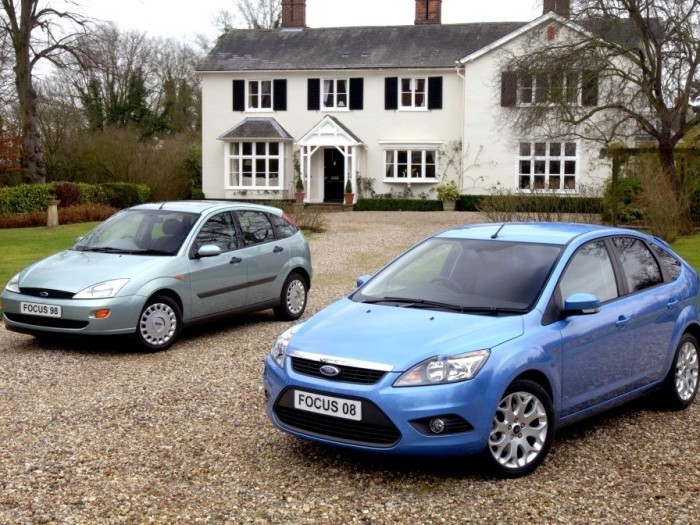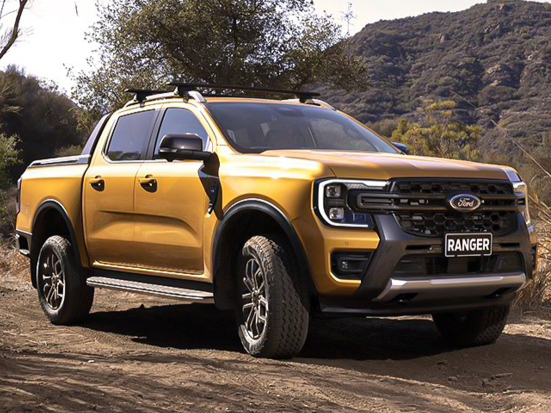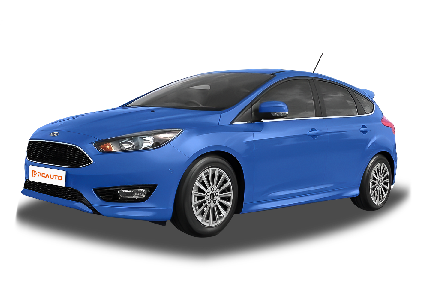Q
Is Ford Focus sedan or SUV?
The Ford Focus has both sedan (four - door three - box car) and hatchback versions. Take the 2017 Ford Focus Sedan 1.5 EcoBoost Titanium+ as an example. From the specifications, we can see that it is 4534mm in length, 1823mm in width, and 1484mm in height. It belongs to the C - segment cars. The layout of 4 doors and 5 seats is a typical feature of sedan. The sedan model has a separate engine compartment, passenger compartment, and luggage compartment. This layout gives the vehicle a more traditional and staid appearance. The trunk space is relatively regular, making it easy to load items.
On the other hand, the two - door hatchback version of the Ford Focus has a more compact rear end design, presenting a more dynamic look. It might offer more flexible handling in some narrow spaces. Consumers can choose the model that suits them according to their different requirements for the exterior styling, space practicality, etc.
Special Disclaimer: This content is published by users and does not represent the views or position of PCauto.
Related Q&A
Q
What's the fuel consumption of Ford Focus?
The official combined fuel consumption of the 2017 Ford Focus 4-door sedan with a 1.5-liter EcoBoost engine, Titanium Plus Edition, is 5.6 liters per 100 kilometers. This figure is measured under specific test conditions stipulated by the manufacturer. However, in real-world driving, the actual fuel consumption can vary due to multiple factors.
For instance, driving style has a significant impact on fuel consumption. An aggressive driving style with frequent rapid acceleration and hard braking usually leads to higher fuel consumption, while smooth and constant-speed driving helps save fuel. Road conditions also play a role. Compared with driving on a flat highway with light traffic, driving on hills or in heavy traffic typically increases fuel consumption.
In addition, vehicle load, tire pressure, and the use of accessories such as the air - conditioning system can all affect the actual fuel consumption of the Ford Focus.
Q
What's the service life of Ford Focus' petrol engine?
The service life of the gasoline engine in the Ford Focus can be different. Generally speaking, if properly maintained, the service life of gasoline engine can last for more than 150,000 to 200,000 miles (about 240,000 to 320,000 kilometers) or even longer. The Ford Focus 1.5 EcoBoost Titanium+ is equipped with a 1498 - cc gasoline engine.
Regular oil changes are crucial because fresh oil lubricates the engine components, reducing friction and wear. Replacing filters, such as the air filter and fuel filter, also enables the engine to take in clean air and get the proper fuel mixture. Timely replacement of belts and hoses that age over time helps prevent unexpected breakdowns. Maintaining good driving habits is also important. Aggressive driving with sudden acceleration and hard braking will damage the engine, while smooth driving can extend the engine's service life. Additionally, following the manufacturer's maintenance schedule for the engine (for the Ford Focus, it might be maintenance at regular intervals of mileage or time) can ensure the engine stays in good working condition over the long term.
Q
Which one is better, Honda Civic or Ford Focus?
The Honda Civic and the Ford Focus each have their own advantages, making it difficult to simply judge which one is better. In terms of appearance, the front end of the Ford Focus has a dynamic design. Its large - sized aluminum alloy wheels are well - matched with the sporty taillight group, giving the car an overall fashionable and tech - savvy look. On the other hand, the Honda Civic may have a more simple and smooth shape.
When it comes to the interior, the Focus' 13.2 - inch floating central control screen creates an excellent technological atmosphere. It also comes with a large - sized sunroof, automatic air - conditioning and other complete configurations. The Civic's interior perhaps focuses more on the balance between comfort and practicality.
In terms of power, the Focus offers a variety of power options, including different turbocharged engines, providing plenty of driving fun. The Civic's power performance can also meet the needs of daily driving, and it may perform well in terms of fuel economy.
The prices of the two cars also vary depending on the specific models and configurations. It is recommended that you go to a dealership to test - drive these two models in person, experience their actual driving feelings, and then select the most suitable model for yourself based on factors such as your budget and your preferences for the appearance and interior.
Q
Is Ford Focus smaller than Corolla?
The 2017 Ford Focus Sedan 1.5 EcoBoost Titanium+ measures 4,534mm in length, 1,823mm in width, and 1,484mm in height, with a wheelbase of 2,648mm. The dimensions of the Corolla vary depending on the version and year. Generally, its length ranges from 4,300mm to 4,600mm, width from 1,700mm to 1,800mm, height from 1,450mm to 1,500mm, and wheelbase typically from 2,600mm to 2,700mm. As we can see, the Ford Focus is bigger than the common Corolla in length, width, height, and also longer in wheelbase.
However, the interior space of a car isn't solely determined by its exterior dimensions. Factors such as the in - car layout design also play a role in the actual space experience. Moreover, there are differences in the dimensions among different Corolla models. A detailed comparison requires the accurate parameters of the actual models. But when compared with the above - mentioned models, the Ford Focus has larger overall dimensions.
Q
Which one is better, Mazda 3 or Ford Focus?
Both Mazda 3 and Ford Focus have their own advantages, so which one is better depends on individual needs and preferences. In terms of price, if you have a limited budget, the Focus might be more suitable as it is relatively affordable. When it comes to configuration, the Mazda 3 has more abundant safety features. Even the base - model is equipped with a tire pressure monitoring system and a vehicle stability control system. Regarding power performance, the Focus is powered by a 1.5 - liter naturally - aspirated engine, while the Mazda 3 offers a choice between a 1.5L and a 1.4T engine, and the 1.4T engine provides stronger power. In terms of exterior design, the Focus has a more masculine look, while the Mazda 3 is more appealing to women. Moreover, the seams on the Mazda 3's center console are more delicate. In terms of space, some testers think that the Mazda 3 has a slight edge in headroom and legroom. All in all, if you focus on price and practicality, the Focus is a good option. However, if you prefer rich configurations and strong power, the Mazda 3 may be a better choice.
Q
What is the fuel economy of Ford Focus?
The official fuel consumption of the 2017 Ford Focus sedan 1.5-liter EcoBoost Titanium Plus Edition is 5.6 liters per 100 kilometers. This figure represents the combined fuel consumption under standard test conditions. In real-world driving, the fuel consumption may vary, which can be affected by factors such as driving style, road conditions, and vehicle load. For example, an aggressive driving style with rapid acceleration and hard braking may increase fuel consumption, while a smoother and more stable driving style may make the actual fuel consumption closer to the official data. Additionally, using features such as the air conditioner and having an excessive vehicle load can also affect the car's fuel consumption. The Focus's fuel consumption of 5.6 liters per 100 kilometers makes it a relatively fuel-efficient model in the compact car segment, helping car owners reduce their vehicle usage costs.
Q
Which model of Ford Focus is the best?
As the criteria for "the best" vary from different people, so it's quite difficult to directly determine which model is the best. Take the 2017 Ford Focus Sedan 1.5 EcoBoost Titanium+ as an example. It is equipped with rich configurations. In terms of power, the 1.5 - liter engine has a maximum horsepower of 182PS. The maximum speed can reach 222km/h, and it can accelerate from 0 to 100km/h in 8.6 seconds. Its power output has certain advantages among cars in the same class. Regarding safety features, it is standard - equipped with a series of safety systems such as ABS anti - lock brakes, vehicle stability control, and lane - change assist, and also has six airbags to comprehensively ensure the safety of drivers and passengers. There are also quite a few comfort features inside the car, like the dual - zone automatic air - conditioning in the front row and Sony speakers. However, if consumers pay more attention to fuel economy, its official combined fuel consumption of 5.6L/100km is quite good. If they prefer space, its 421L trunk volume is just average. So, the best model depends on individual's preferences.
Q
Is Ford Focus a small or mid-size car?
The Ford Focus is a small car, specifically a C-segment or compact sedan. It has a body length of 4,534 millimeters, a width of 1,823 millimeters, a height of 1,484 millimeters, and a wheelbase of 2,648 millimeters. These dimensions are typical specifications for a compact sedan. In the automotive classification, compared with mid-size or large vehicles, compact sedans are known for their relatively small size, which makes them easier to be driven in the city.
Compact sedans like the Ford Focus are popular among many consumers for their affordable price, good fuel economy, and easy parking. The Ford Focus is an excellent choice for daily commuting and city driving. And as a compact sedan, it also offers an ample interior space and features, such as a 55-liter fuel tank and 421 liters of trunk space.
Q
How far can a Ford Focus travel on an empty fuel tank?
Generally speaking, it's not recommended to drive your car until the fuel runs out completely, as this can potentially damage components like the fuel pump. However, in theory, if we estimate based on the information of the 2017 Ford Focus Sedan 1.5 EcoBoost Titanium+, its fuel tank capacity is 55 liters, and the official combined fuel consumption is 5.6 liters per 100 kilometers. Calculated at this fuel - consumption level, the theoretical driving range of this car when the tank is full is about 982 kilometers.
However, the actual range is affected by various factors. For example, driving style is an important factor. Frequent hard acceleration and sudden braking increase fuel consumption and reduce the range. Road conditions also play a role. Driving in congested traffic or on mountain roads can cause the fuel consumption to go up. Vehicle load is another factor. Having more passengers or carrying a large amount of items in the car will make it "thirstier" for fuel. So, in actual use, the range of this car will be less than the theoretical value, and the specific figure depends on the actual driving conditions.
Q
What is special about Ford Focus?
The Ford Focus has many distinctive features. It is equipped with a 1.5-liter EcoBoost engine that strikes a great balance between performance and efficiency. The maximum speed can reach up to 222 km/h, and the official 0 - 100 km/h acceleration time is 8.6 seconds. Meanwhile, the official combined fuel consumption is relatively low, at 5.6 liters per 100 kilometers.
In terms of safety, it is equipped with a series of standard features, such as six airbags, an Anti-lock Braking System (ABS), a Vehicle Stability Control system, and a variety of active safety systems. Comfort and convenience are also well - guaranteed. It offers a dual - zone automatic air - conditioning system and a Sony audio system for the front row, along with keyless operation and a single sunroof.
The interior design focuses on ergonomics, creating a "flight cockpit" feel. The 60:40 split - folding rear seats enhance the vehicle's practicality. Moreover, the exterior features a modern and dynamic design with sharp lines, which has won the favor of many consumers.
Popular Cars
Model Year
Car Compare
Car Photo
Latest Q&A
Q
Does the 2019 Golf GTI have a timing belt or chain?
The 2019 Golf GTI uses a timing chain instead of a timing belt—a design that offers better durability and lower maintenance costs. Typically, a chain lasts as long as the engine itself and rarely needs replacement, whereas a belt requires inspection or replacement every 60,000 to 100,000 km. If neglected, a worn belt can snap and cause severe engine damage.
VW’s EA888 engine family has long relied on chain-driven systems, which are relatively quiet and highly reliable. That said, it’s crucial to periodically check the tensioner’s condition. Some earlier models experienced timing issues due to tensioner design flaws, but this was addressed in the 2019 version.
For performance enthusiasts, a chain system handles high-revving stress better, making it a common choice for hot hatches like the GTI. For daily driving, just stick to VW 50400/50700-spec oil as recommended in the manual—proper lubrication keeps the chain system healthy long-term.
One heads-up: If you hear noticeable metallic rattling near the front of the engine, have the guides or tensioner inspected ASAP. Unlike the telltale belt squeal before failure, this noise is a classic sign of chain-related wear.
Q
What is the recall on the 2019 GTI?
The 2019 Volkswagen Golf GTI was subject to a safety recall addressing two potential issues. First, the fuel pump control unit software could malfunction, potentially causing engine stalling in rare cases. Second, some vehicles might have rear suspension stabilizer link bolts that weren't tightened to specification, posing a loosening risk. Owners can visit authorized dealers for free software updates or bolt retightening.
These proactive recalls demonstrate Volkswagen's commitment to safety. Dealers often handle outstanding recall items during routine maintenance.
For performance-oriented models like the GTI, it's wise to go beyond recall checks. Pay close attention to the turbo system, DSG transmission fluid, and brake wear—these components endure more stress during spirited driving. If warning lights appear or you notice unusual noises, get a professional inspection promptly. Keeping the car in top shape ensures you can fully enjoy its dynamic capabilities.
Q
Does the 2019 GTI require premium gas?
The 2019 GTI does recommend using high-octane fuel (typically RON 95 or above). Its 2.0L turbocharged engine has a relatively high compression ratio, and premium gas ensures optimal performance while reducing knock risk. It also helps maintain engine cleanliness and long-term reliability.
While the car may tolerate lower-octane fuel (like RON 92), you’d see slightly reduced power output and fuel efficiency. Over time, it could also affect engine longevity. Turbocharged engines are particularly sensitive to octane ratings since turbos generate higher heat and pressure—high-octane fuel handles these conditions better.
Mixing different fuel grades occasionally won’t hurt, but sticking to the manufacturer’s recommendation is ideal. Also, periodic fuel additive treatments can help clean carbon buildup, especially for direct-injection engines.
One more thing: even with the same octane rating, fuel additive packages vary by brand. So, picking a reputable gas station matters too.
Q
How long will a 2019 GTI last?
The lifespan of a 2019 GTI largely depends on maintenance and driving habits. With regular oil changes, transmission fluid replacements, and avoiding aggressive driving, it can easily clock over 200,000 kilometers—or even more. Its 2.0T engine and DSG gearbox are proven combos, and as long as you stick to the factory service schedule, mechanical reliability won’t be an issue.
Just keep in mind: turbocharged engines demand extra care. Always use the right spec full-synthetic oil and monitor the cooling system. Climate plays a role too—hot, humid conditions mean paying extra attention to rubber seals and electronics. Every 50,000 km, have the timing chain and high-pressure fuel pump inspected (key items for turbos).
Driving style matters. Don’t redline it constantly, and let the engine warm up properly after cold starts. Rustproofing helps long-term durability, so regular underbody washes are smart. Nail these details, and this car’s built to last.
Q
How fast is the 2019 GTI?
The 2019 GTI truly delivers when it comes to performance. Under the hood lies a punchy 2.0-liter turbocharged four-cylinder, churning out 228 horsepower and 350 Nm of torque. Whether you opt for the engaging 6-speed manual or the lightning-fast 7-speed DSG, this hot hatch rockets from 0-100 km/h in just 6.3 seconds, with an electronically limited top speed of 250 km/h.
What really sets the GTI apart is its razor-sharp handling. The sport-tuned suspension and electronic differential lock work together to deliver precise steering and rock-solid cornering stability. It’s the perfect blend of everyday practicality and proper driver’s car thrills—a well-rounded hot hatch in every sense.
For enthusiasts, the GTI’s tuning potential is massive. Many owners go for ECU remaps or intake/exhaust upgrades to squeeze out even more power. Just remember to keep things street-legal—safety and compliance should always come first. Around here, these pocket rockets have a solid following, and it’s easy to see why.
View MoreRelated News

Ford Focus will cease production in 2025, shifting strategic emphasis towards electrification
Kevin WongMar 10, 2025

Ford Focus is about to cease production in November and may return in 2027 in the form of an SUV.
WilliamSep 15, 2025

2025 Ford Ranger WildTrak launched, the most powerful diesel version in the Ranger lineup
MichaelAug 25, 2025

Is the Ford Ranger V6 about to enter Malaysia?
LienAug 13, 2025

Reviewing the Ford Ranger: The Dual Advantages of Rugged Appearance and Powerful Performance
Kevin WongApr 21, 2025
View More

















Pros
Cons